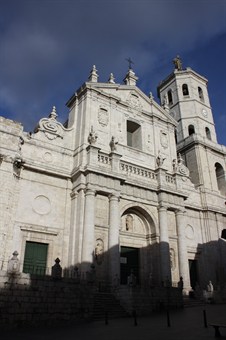The Cathedral
 The Cathedral of Valladolid is one of the most singular and well known examples of Castilian art in the Early Modern age. Although the initial draft of Juan de HerreraJuan de Herrera (1530-1597) was one of the leading exponents of Renaissance architecture in Spain. His main work is the Monastery of El Escorial, the residence built by order of King Philip II and completed in 1584. Other famous products of his mastery were also the projects of Valladolid Cathedral and the Royal Palace of Aranjuez, buildings, however, which not were concluded before the artist’s death. Herrera was also a student of mathematics and geometry. was clearly influenced by the Renaissance, the Cathedral of Nuestra Señora de la Asunción (Our Lady of the Assumption), left unfinished, was enriched in the course of the seventeenth and eighteenth centuries, with additions and modifications in Baroque style.
The Cathedral of Valladolid is one of the most singular and well known examples of Castilian art in the Early Modern age. Although the initial draft of Juan de HerreraJuan de Herrera (1530-1597) was one of the leading exponents of Renaissance architecture in Spain. His main work is the Monastery of El Escorial, the residence built by order of King Philip II and completed in 1584. Other famous products of his mastery were also the projects of Valladolid Cathedral and the Royal Palace of Aranjuez, buildings, however, which not were concluded before the artist’s death. Herrera was also a student of mathematics and geometry. was clearly influenced by the Renaissance, the Cathedral of Nuestra Señora de la Asunción (Our Lady of the Assumption), left unfinished, was enriched in the course of the seventeenth and eighteenth centuries, with additions and modifications in Baroque style.
In the eleventh century there were already three collegiate churches, even though it was not a diocese (Valladolid, in fact, was part of the diocese of PalenciaNow belonging to the current Comunidad Autónoma de Castilla y León, Palencia had its heyday in the Middle Ages. Already a bishopric under the Visigoths, the city was home to the oldest Spanish university, approved by Pope Honorius III in 1221 but disappeared after a few decades. In the Early modern Age it shared the fate of Castile: as the centre of the empire of Charles V and the monarchy of Philip II, it also underwent a severe crisis during the seventeenth century.). The works for the construction of the fourth collegiate church began in 1585, led by Diego de PravesDiego de Praves (1556-1620) was an important Spanish architect of the Early Modern period. He was maestro mayor of the Cathedral of Valladolid, but worked on many of the city’s most significant landmarks, such as the Church of the Vera Cruz (True Cross) and the convent of the Descalzas Reales (Royal Discalced)., designed by Juan de Herrera. At the request of Philip II, the collegiate church was elevated to the rank of cathedral and Valladolid became an episcopal see in 1595, a year before it was granted the title of city. The lack of funds and the transfer of the court to Madrid in 1606 slowed the work down and Herrera’s design was only half finished. The Renaissance and Classical appearance and structure were introduced in later decades. The upper part of the main façade, the one that looks to the south, was finished in 1733 in Baroque style by the architect Alberto de ChurrigueraAlberto de Churriguera (1676-1750) was a member of the family which, more than any other, has represented Baroque architecture in Spain. Maestro Mayor of Salamanca’s Catedral Nueva, in the same city he conducted the first phase of the construction of the Plaza Mayor. Often together with his brothers and nephews, he worked on the Cathedral of Palencia, the façade of the cathedral of Valladolid and many other projects, also in Madrid.. The tower was erected in the same period though it collapsed a few decades later, after the great earthquake of 1755, while the tower that still exists today dates back to 1841 and deviates significantly from Herrera’s original project. The interior of the cathedral follows the model of sober Herrerian Classicism but also in this case there is no lack of Baroque elements in it. The retablo mayor from the nearby church of Santa María la Antigua stands out, the work of Juan de JuniJuan de Juni (1506-1577) was born in France but lived most of his life in Spain, especially in Valladolid. Along with Alonso Berruguete he gave birth to the great Castilian school of sculpture, and now most of his work is preserved in the Museo Nacional de Escultura and in the Museo Diocesano y Catedralicio of Valladolid. He made statues, retables and decorative elements for façades and portals, using different materials, from wood to stone., and the choir stalls (the Sillería) is from the Church of San Pablo. Both are preserved in the Capilla Mayor. In other chapels, there was a picture of the Transfiguration attributed to Luca Giordano (Capilla del ábside) and the funerary statues in alabaster of the Venero y Leyva family (Capilla de San José). Inside the cathedral is also home to the Diocesan Museum, which opened in 1965.
